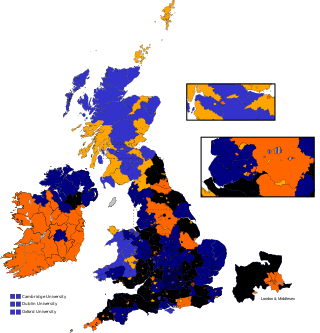Related Research Articles

The West Riding of Yorkshire was one of three historic subdivisions of Yorkshire, England. From 1889 to 1974 the riding was an administrative county named County of York, West Riding. The lieutenancy at that time included the city of York and as such was named "West Riding of the County of York and the County of the City of York". The riding ceased to be used for administrative purposes in 1974, when England's local government was reformed.

The Representation of the People Act 1867, known as the Reform Act 1867 or the Second Reform Act, is an act of the British Parliament that enfranchised part of the urban male working class in England and Wales for the first time. It took effect in stages over the next two years, culminating in full commencement on 1 January 1869.

Birkenhead is a constituency in Merseyside represented in the House of Commons of the UK Parliament since 2024 by Alison McGovern of the Labour Party.

South Norfolk is a constituency in the House of Commons of the UK Parliament represented by Ben Goldsborough, a member of the Labour Party, after winning the seat in the 2024 general election.

Staincross was a Wapentake, which is an administrative division, in the historic county of the West Riding of Yorkshire. It consisted of seven parishes, and included the towns of Barnsley and Penistone
Barkston Ash was a parliamentary constituency centred on the village of Barkston Ash in the West Riding of Yorkshire. It was represented in the House of Commons of the Parliament of the United Kingdom from 1885 until 1983. It elected one Member of Parliament (MP) by the first past the post system of election.

Hackney North was a parliamentary constituency in "The Metropolis". It returned one Member of Parliament (MP) to the House of Commons of the Parliament of the United Kingdom.
Bradford was a parliamentary constituency in Bradford, in the West Riding of Yorkshire.

West Riding of Yorkshire was a parliamentary constituency in England from 1832 to 1865. It returned two Members of Parliament (MPs) to the House of Commons of the Parliament of the United Kingdom.

Leeds was a parliamentary borough covering the town of Leeds, in the West Riding of Yorkshire, England. It was represented in the House of Commons of the Parliament of the United Kingdom from 1832 to 1885.
Holmfirth was a parliamentary constituency centred on the town of Holmfirth in the West Riding of Yorkshire. It returned one Member of Parliament (MP) to the House of Commons of the Parliament of the United Kingdom, elected by the first past the post system.
Osgoldcross was a parliamentary constituency in the Osgoldcross Rural District of West Yorkshire. It returned one Member of Parliament (MP) to the House of Commons of the Parliament of the United Kingdom, elected by the first past the post system.
Northern West Riding of Yorkshire was a parliamentary constituency covering part of the historic West Riding of Yorkshire. It returned two Members of Parliament (MPs) to the House of Commons of the Parliament of the United Kingdom, elected by the bloc vote system.
Eastern West Riding of Yorkshire was a parliamentary constituency covering part of the historic West Riding of Yorkshire. It returned two Members of Parliament (MPs) to the House of Commons of the Parliament of the United Kingdom, elected by the bloc vote system.
EastEssex, formally known as the East Division of Essex was a parliamentary constituency in the English county of Essex. From 1868 to 1885, it returned two Members of Parliament (MPs) to the House of Commons of the Parliament of the United Kingdom, using the bloc vote system of election.
Mid Lincolnshire, formally called the Mid Division of Lincolnshire, was a county constituency in Lincolnshire. It returned two Members of Parliament (MPs) to the House of Commons of the Parliament of the United Kingdom, elected by the bloc vote electoral system.

South Lincolnshire, formally called the Southern Division of Lincolnshire or Parts of Kesteven and Holland, was a county constituency in Lincolnshire. It returned two Members of Parliament (MPs) to the House of Commons of the Parliament of the United Kingdom, elected by the bloc vote electoral system.
The ceremonial county of Cheshire, which comprises the unitary authorities of Cheshire East, Cheshire West and Chester, Halton and Warrington, has returned 11 MPs to the UK Parliament since 1997.
The county of Durham has returned 7 MPs to the UK Parliament since 1983. Under the Local Government Act 1972, which came into effect on 1 April 1974, the boundaries of the historic/administrative county were significantly altered with the north-east of the county, comprising more than half the electorate, being transferred to the new metropolitan county of Tyne and Wear. In addition, the borough of Hartlepool was included in the new county of Cleveland. These changes were reflected in the following redistribution of parliamentary seats which did not come into effect until the 1983 general election, resulting in a reduction in the county's representation from 16 to 7 MPs.
References
- ↑ Birkenhead Enfranchisement Act 1861 (c.112), section 1.
- ↑ "Representation of the People Act 1867" (PDF). Retrieved 23 May 2020.
- 1 2 3 4 5 Craig, F. W. S., ed. (1977). British Parliamentary Election Results 1832-1885 (e-book) (1st ed.). London: Macmillan Press. p. 494. ISBN 978-1-349-02349-3.